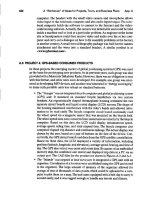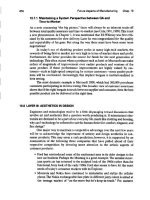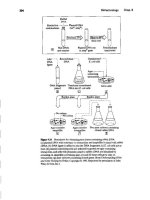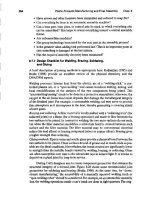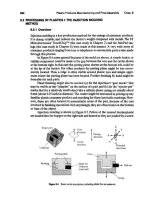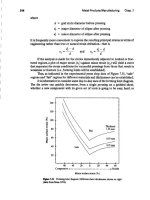21st Century Manufacturing Episode 2 Part 5 ppt
Bạn đang xem bản rút gọn của tài liệu. Xem và tải ngay bản đầy đủ của tài liệu tại đây (586.95 KB, 20 trang )
274
Computer Manufacturing Chap. 6
internal height for the electrical subsystems is 0.78 inch. Special features on the
bottom case are the circular busses fur mounting the PCB, the through window for
the battery set, and various mechanical dimensions and shapes of electrical switches.
Such features needed to be compatible with the work of the electrical design team.
6.8.7 Coupling Constraints Originating in the Electrical
Domain
IC.>ml
Other constraints originated on the "electrical side" and had to be accommodated
on the "mechanical side." They are given the symbol
C~>m'
They were as follows:
•The "z-height" of certain large devices on the PCBs were flagged and con-
veyed to the mechanical designers for consideration. Often this exchange
resulted in more favorable packaging and overall space saving.
•Various switches,volume control knobs,and other 110were of coursemounted
on the side of PCBs and their precise dimensions were conveyed to the
mechanical team. Ultimately, this meant that they protruded through the
plastic casing's boundary with user-friendly dimensions. These components
were a power connector, a power switch,serial/parallel ports, audio 110jacks,
a keyboard jack, two volume control knobs, and a connector for an attachable
color display.
•Certain devices,such as the power supply,required electromagnetic shielding.
Once the sites for these deviceswere determined their dimensions were shared
with other teams.
•The locations and sizes of the mounting holes that attached the PCB to the
bottom casing were also the product of a dialogue between electrical and
mechanical designers.
Figure 6.28shows the PCB layout of the InfoPad terminal with these electrical
constraint features highlighted. To present these electrical constraints to mechan-
ical designers in the DUCADE environment. electrical constraints along with the
design were transformed into mechanical representation (3-D solid models) for
analysis.The approach captured only the geometric aspects of the electrical design
constraints. Methods for presenting other types of electrical constraints are still
under development.
6.8.8 Resolving the Coupling and Constraints (C.<>m)
After several iterations between the mechanical and electrical design teams, satis-
factory compromises were achieved. TIley are given the symbol
Ce<>m'
The evi-
dence in firms such as Hewlett-Packard and Sony is that, over many product
revisions,these couplings can be further refined and the product gets more efficient
and compact (Cole, 1999).In fact, an interesting exercise for students is to "dissect"
several generations of the familiar Sony Walkman and see how the engineers have
invented new ways of resolving the constraints
(Ce<>m)'
For a first prototype there
6.8 Case Study on Computer Manufacturing
275
Flpre 6.28 PCB layout and some electrical constraints.
is a limit to how much can be achieved in the first few iterations. Nevertheless for
the InfoPad the main constraints were resolved, leading-to the following new
aspects of the "final" design:
•The PCB design was changed to a customized "U shape." It provided a smaller
form factor for the new specification and allowed accessto the selected battery set.
• Some important electrical components were redesigned using different Ie
packaging and different surface mounting techniques. 1bis reduced the device
sizes and allowed them to fit into the smaller interior space of the mechanical
casing.
• The boundary features of the mechanical casing were changed for the added
audio. keyboard jacks, two serial ports, and the color video unit.
• The interior contour of the mechanical casing was modified according to the
shape of the new PCB. Circular bosses were added and modified on the bottom
casing for mounting the newly designed PCB.
• Curved, spline features were added to the two sides of the terminal casing to
improve the ergonomic and aesthetic design (Figure 6.29).
Two volume controls
i
Color di~playconnttlor
Mounung holes
Power connector
AUdio~
276
6.8.9 Fabrication
Computer Manufacturing Chap. 6
F'lgme6.29 CAD solid model ofthe
Tl'IfnPlld
The MOSIS service was used for the various ICs <www.mosls.org>,thePCBswere
"fabbed" at a local bureau <>. and the molds were
fabricated on the CyberCut service <cybercut.berke1ey.edu>. The design of the
molds for plastic injections involved the precise specification of taper angles for sep-
arating the mold halves, shrink factors for different materials, core design, running
gate design, and parting plane specification. Prototype molds and casings are shown
in Figure 6.30.
F1pre 6.30
Top:
the aluminum mold
halves; bottom; the injection molded
plastic casings,
CHAPTER
METAL-PRODUCTS
MANUFACTURING
7.1 INTRODUCTION
7.1.1 The "Garag Shop at www.start·up-eompany.com
The sepia photograph above, taken around 1917, shows William Woodland, one of my
grandfathers. He was an aircraft mechanic. He is sitting in the cockpit of a Vickers
VlJDIOY
biplane.
My
other
grandfather, Browett Wright, was a
railroad
engineer;
specifically he was a "knocker." He walked around the stockyards at Watford Junction,
277
278
Metal-Products Manufacturing Chap. 7
on the outskirts of London, carrying a small hammer.
By
lightly knocking on the
wheels
and
axles
of
wagons, and listening
tu the
resulting "ring,"
his
well-trained
ear
could detect the absence or presence of potentially dangerous fatigue cracks.
As a hobby, these men and their friends often set up small machine shops in
their garages or basements where they would fabricate small personal projects.
Sometimes, around the Christmas consumer season, they even did small-batch man-
ufacturing
runs for local suppliers/wholesalers.
The garage shop allowed autonomy, custom fabrication, and reasonably good
delivery times. A wide variety of projects could be accomplished with a well-
equipped tool chest and just two main machines: a small lathe and a medium-sized
three-axis milling machine. A drill press was an inexpensive addition that saved these
men from setting up the entire mill just to drill a hole. If a few extras were added-c.
such as a bench grinder, a small sheet-metal press, and a welding ser-e-then they were
really in business.
Many of today's famous figures in Silicon Valley and elsewhere also began their
start-ups in a humble garage. It is most likely that many of these garages contained
these basic tools in their early days.
The most important point is this: these simple metal-cutting machines allow a
range of parts to be made. The same set of cutting tools can be used to make a wide
variety of parts of rather complex geometry. Machining is the most important metal-
forming operation for this reason, despite the more glamorous appeal of FDM and
other SFF processes. In the last few decades, machining has endured a bad reputa-
tion for being wasteful and for being a little slow, but it always bounces back in
fashion for these reasons of flexibility and good accuracy.
7.'.2
The Origin. of the Basic Machine Shop
From these humble origins emerges the job shop or machine shop-really just a
larger version of the garage shop but with bigger machines, more specialized
machines, and perhaps several machinists. However, in the end it all boils down to
flexibility and specialized service with reasonable delivery.
Machining is a powerful way of producing the outer structures of weird proto-
types that are just beginning the product development cycle or perhaps just entering
the market: products located in the lower left comer of Figure 2.3. Also the job shop
in a university or research laboratory is a place where machinists turn the new
designs of mad inventors into reality.
All over the world, unusual start-up companies are being formed: computer
start-ups, biotech firms, in fact any new-product companies. At some point these
companies will need a prototype, often to show the bank. for a loan or to impress
potential investors. Most likely,the company will need to go to a machine shop to get
the prototype made. For example, the first few Infopad casings-c-see Chapter 6-
were readily machined with good tolerances of +1-0.002 inch
(-50
microns). The
fabrication time was approximately three days from the moment the design was
fixed until a finished casing was fabricated by milling.
7.1 Introduction
279
7.1.3 The Tool and Die Shop-Machining and EDM
Metal cutting is more ubiquitous in industrial society than it may appear from the
preceding description of the traditional machine shop. All forgings, for example
those used in cars and trucks, and many sheet metal products, for example those used
in steel furniture and filing cabinets, are formed in dies that have been machined.
In
fact, most of today's electronic products are packaged in a plastic casing that has
been injectio~olded into a die: cellular phones, computers, music systems, the
Walkman, and all such products thus depend on the cutting of tools and dies for other
processes that follow metal cutting. While the initial prototype of a new cellular
phone might well be created with one of the newer rapid prototyping processes that
emerged after 1987-stereolithography (SLA), selective laser sintering (SLS), or
fused deposition modeling (FDM)-the final plastic products, made in batch sizes in
the thousands or millions (see Chapter 8), will be injection-molded in a die that has
been cut in metal with great precision and surface finish constraints.
The machining of such dies, usually from highly alloyed steels, requires some of
the most exacting precisions and surface qualities in metal-cutting technology. It
prompts the need for new cutting tool designs, novel manufacturing software that
can predict and correct for tool deflections and deleterious burrs, and new
CAD/CAM procedures that incorporate the physics and knowledge bases of
machining into the basic geometrical design of a component. At the same time it
should be noted that if the die is a complex shape, a two-step macbining process may
be needed. First, the "roughing cuts" will be done with conventional end milling as
shown in Section 7.2.4. Second, the "finishing operations" willbe created by the elec-
lrodischarge machining (EDM) process. In this process, a shaped carbon electrode
slowly "sinks't into the metal mold. Electric arcing between the electrode and die sur-
face takes place in a,dielectric bath. Material removal takes place by surface melting
of the die surface and flushing the debris away with the dielectric fluid.
7.1.4 Full-Scale Production Using Machining Operations
The previous sections focus on small-batch manufacturing operations that generate
a small number ofparts, or even one-of-a-kind dies. In other sectors of industry,large-
batch manufacturing is more the normal situation. Thus machining in all its forms-
turning, milling, drilling, and the like-can also be seen as a large-scale manufacturing
process. It supports mass-production manufacturing such as the auto and steel indus-
tries, both positioned well along the market adoption curve in Figure 2.2.
To summarize this economic importance, the cost of machining amounts to
more than 15% of the value of all manufactured products in all industrialized
countries. Metcut Research Associates in Cincinnati, Ohio, estimates that in the
United States the annual labor and overhead costs of machining are about $300
billion per year (this excludes work materials and tools). U.S. consumption of
new machine tools (CNC lathes, milling machines, etc.) is about $7.5 billion per
year. Consumable cutting tool materials have U.S. sales of about $2 to $2.5 bil-
lion per year. For comparison purposes, it is of interest to note a ratio of $300 to
280
Metal-Products Manufacturing Chap. 7
$7.5
to
$2.5 billion for labor costs
to
fixed machinery investments
to
disposable
cutting tools.
7.1.5 Full-Scale Production Using Other Metal-Processing
Operations
Sheet rolling
is also a large-batch manufacturing process in which a rolling mill contin-
uously produces flat strip in coils.Such strip is sold to a secondary producer, who will
shear it into smaller blanks that are then pressed into an ordinary soup can or filing cab-
inet. The sheet-metal forming of single discrete items, such as the hood of a car, is also a
large-batch manufacturing process because many similar parts are produced on a con-
tinuous basis from one very expensive die.This chapter considers these other examples
of large-batch manufacturing, focusing as an example on sheet-metal forming.
The machines and dies for all these processes are extremely expensive, so the
analysis of the forces on the machines and dies is crucial. As managers of technology,
a very valuable service is created if these force predictions lead to sensible machinery
purchases-that is, machines that are powerful enough to deform the typical mate-
rials and products being created by a company, but not overly powerful, hence
wasting capability and investment costs. At the same time, the understanding of
which factors affect quality assurance and the properties of the deformed material is
equally important.
7.2 BASIC MACHINING OPERATIONS
7.2.1 Planing or Shaping
A cutting tool moves through a steel block and removes a layer from its top surface
(Figure 7.1). The discarded layer is called the chip. The mental image that seems to
work well even in sunny California is that of a handheld snow shovel being pushed
along a snow-covered sidewalk. The shovel is analogous to the tool, and the chip that
rises up the face of the tool-actually called the
rakeface-is
analogous to the layer
of snow.
The chip then curls away from the face at some distance, called the chip-tool
contact length, and falls away onto the surface being machined or to one side. If the
shovel face made a perfect right angle with the sidewalk, the rake angle would be
o
degrees. Of course, a snow shovel is usually tilted back to a rake angle of about
20 or 30 degrees. In metal machining the rake angle for today's tools is often
6 degrees. It isalso quite common in metal machining for the rake face to be at a slight
negative angle of
-6
degrees. This gives added strength to the delicate cutting edge.
Wood planing has a similar
geometry
to metal cutting by planing. However, this
is not altogether the best analogy because in wood cutting the
physics
of the process
is different: the wood ahead of the sharp cutting edge is split, and a long crack runs
ahead of the tool to make for rather modest cutting forces.
In the machining of metals, although a ductile crack of microscopic proportions
is obviously formed right down near the tip of the tool (otherwise the two surfaces
would not separate), most of the work done is related to the shearing of metal in the
shear plane.
The shear plane is shown as OD in Figure 7.2.
7.2 Basic Machining Operations
2.,
Ftcure 7.1 Micrograph of chip formation.
In Figure 7.2 and accompanying equations, the shear plane angle is related to
the undeformed chip thickness
t
and the deformed chip thickness
t
e
. It is common to
define a chip thickness ratio (r
==
tJ(.). Since the chip slows down by frictional drag
on the tool, tei:; always greater than
t.
Thus r is always less than unity.
In the special case in which the rake angle,
a,
is set to zero, it can be seen that
the tangent of the shear plane angle is just the undeformed chip thickness divided
by the deformed chip thickness. lithe main cutting forces
(F
c
and
F
T
)
are measured
with a force dynamometer, they can be resolved onto the all-important forces on the
cutting edge of the tool. Why are these other forces
F
N
and
F
R
important? The
answer is that they govern the life of the tool. Large values of F R will create high
shear stresses and temperatures in this region. A high value of
F
N will be associated
with a high normal pressure on the delicate cutting edge. Such high forces will create
high friction and wear of the rake face. A large value of F
R
will also tend to lift the
tool away from the surface being machined and make the surface finish irregular. It
is therefore worth paying for lubricants and diamond-coated tools that minimize
this force.
7.2.2 Turning
The basic operation of turning (also called semiorthogonal cutting in the research
laboratory) is also the one most commonly employed in experimental work on metal
cutting. The work material is held in the chuck.of a lathe and rotated. The tool is held
rigidly in a tool post and moved at a constant rate along the axis of the bar, cutting
282
Metal-Products Manufacturing Chap. 7
tan oil
= 1
~~~~{[o:
Where
r=i<1
Also note
F~,=Frsino:+FTcos(l
P/I P,cosQ;-FTsina
Figure 7.2 Cutting forces during chip fonnation.
away a layer of metal to form a cylinder or a surface of more complex profile. This is
shown diagrammatically in Figure 7.3.
The cutting speed (V) is the rate at which the uncut surface of the work passes the
cutting edge of the tool, usually expressed in units offtlmin or m min-to The
feed
(f)
is the distance moved
by
the tool in an axial direction at each revolution of the work.
The
depth-of-au
(w)
is the thickness of metal removed from the bar, measured
in a radial direction.' The product of these three gives the rate of metal removal, a
parameter often used in measuring the efficiency of a cutting operation.
v
f
w
=
rate of removal
(7.1)
"nie feed rate
(I)
during turrung is also called the undcformed chip thickness (r).The depth-of-
cut,
W,
in turning is also referred to as the undeformed chip width. Since machining has developed from
II
practitioner's viewpoint, the terminology is not really consistent from one operation to another. For
example, in the diagrams for end milling, the term depth-ol-cut is used in
II
different way.
ntis
is unfortu-
nately confusing for
II
new student of the field. Perhaps the best way to accommodate these inconsisten-
cies is to always view the "slice" of material being removed as the "undeformed chip thickness" (r) and the
direction normal to this (into the plane of the paper) as the "undefonned chip width" (w).
7,2 Basic Machining Operations
283
FIaure 7.3 Lathe turning showing a vertical cross section at top right and a detail
of the insert geometry at bottom right, The dynamometer platform and the remote
the£mowuple on the haltom of the insert are not used during today's production
machining. However they are useful in the research laboratory for routine
measurement of cutting forces and overaU temperature,
The cutting speed and the feed are the two most important parameters that can be
adjusted
by
the operator or programmer to achieve optimum cutting conditions. The
depth of cut is often fixed
by
the initial size of the bar and the required sfze of the
product.
Workmate-rial
Sh"Mpbnc>l-llgJe
Deplhofci.!l,d
Held in
chuck
Chip
-PcedJ
Dynamometer
284
Metal-Products Manufacturing Chap.7
Cutting speed is usually between 3 and 200 m min
-1
(10 and 600
ft/min).
How-
ever, in modem high-speed machining, speeds may be as high as 3,500 m
min-
1
when
machining aluminum alloys. The rotational speed (rpm) of the spindle is usually con-
stant during a single operation, so that when cutting a complex form the cutting speed
varies with the diameter being cut at any instant. At the nose of the tool the speed is
always lower than at the outer surface of the bar, but the difference is usually small
and the cutting speed isconsidered as constant along the tool edge in turning. Recent
computer-controlled machine tools have the capacity to maintain a constant cutting
speed,
V,
by varying the rotational speed as the workpiece diameter changes.
Feed may be as low as 0.0125 mrn (0.0005 inch) per revolution and with very
heavy cutting up to 2.5 mm (0.1 inch) per revolution. Depth of cut may vary from
o
over part of the cycle to over 25 mrn (1 inch). It is possible to remove metal at a
rate of more than 1,600 em' (100 inches") per minute, but such a rate would be very
uncommon, and 80 to 160 em' (5 to 10 inches") per minute would normally be con-
sidered rapid.
As described, the surface of the tool over which the chip flows is known as the
rake face. The cutting edge is formed by the intersection of the rake face with the
clearance face or flank of the tool. The tool is so designed and held in such a position
that the clearance face does not rub against the freshly cut metal surface. The clear-
ance angle is variable but often on the order of 6 to 10 degrees. The rake face is
inclined at an angle to the axis of the bar of work material, and this angle can be
adjusted to achieve optimum cutting performance for particular tool materials, work
materials, and cutting conditions. The rake angle is measured from a line parallel to
the axis of rotation of the workpiece (Figures 7.2 and 7.3). The nose of the tool is at
the intersection of all three faces and may be sharp, but more frequently there is a
nose radius between the two clearance faces.
7.2.3
Drilling
In drilling, carried out on a lathe or a drilling machine, the tool most commonly used
is the familiar twist drill. The "business end" of a twist drill has two cutting edges. The
rake faces of the drill are fanned by part of each of the flutes, the rake angle being
controlled by the helix angle of the drill. The chips slide up the flutes, while the end
faces must be ground at the correct angle to form the clearance face.
An essential feature of drilling is the variation in cutting speed along the cut-
ting edge. The speed is a maximum at the periphery, which generates the cylindrical
surface and approaches zero near the centerline of the drill, the web (Figure 7.4),
where the cutting edge is blended to a chisel shape. The rake angle also decreases
from the periphery, and at the chisel edge the cutting action is that of a tool with a
very large negative rake angle.
7.2.4 Milling
Both grooves and flat surfaces-for example, the faces of a car cylinder block-are
generated by milling.
In
this operation the cutting action is achieved by rotating the
tool while the work is clamped on a table, and the feed action is obtained by moving
it under the cutter (Figure 7.5).
FigW'e7.4
The twist drill.
(c)
(
~,""",'in""rl'~
t;I
a Insert (carbide)
t;I
Support for insert
(lIdjust ,wuht.)
LockingWedgeS~
Clamps lock
inserts in place
(d)
figure?.! Milling cutters: (a) up milling, (b) climb milling,(c) edge milling.and (d) detail efface
milling with indelU\ble inserts the inserts protrude below the tool bolder.
28&
Helix angle e rake angle
Clearance angle .
Cutting edges
W.b
F!ule
4
286
Metal-Products Manufacturing Chap. 7
MilJing is used also for the production of curved shapes, while end mills
(Figure 7.6), which are larger am] more robust versions of the dentist's drill, are
employed in the production of hollow shapes such as die cavities. The end mill can
be used to machine a feature such as a rectangular pocket with (ideally) vertical
walls.
There are a very large number of different shapes of milling cutter for different
applications. Single toothed cutters are possible, but typical milling cutters have a
number of teeth (cutting edges), which may vary from 2 to over 100. The new surface
is generated as each tooth cuts away an arc-shaped segment, the thickness of which
is the feed or tooth load. Feeds are usually light, not often greater than 0.25 mm
(0.01 inch) per tooth, and frequently less than 0.025 nun (0.001 inch) per tooth. How-
ever, because of the large number of teeth, the rate of metal removal is often high.
The feed often varies through the cutting part of the cycle.
In the orthodox side milling operation shown in Figure 7.5a, the feed on each
tooth is very small at first and reaches a maximum where the tooth breaks contact
with the work surface. If the cutter is designed to "climb mill" and rotate in the oppo-
site direction (Figure 7.5b), the feed is greatest at the point of initial contact.
In practice it is observed that the sideways pressure on an end cutter can deflect
it away from the vertical surface, as shown in Figure 7.7. Since the slender end mill is
like a cantilever beam, the deflection is more pronounced down at its tip. Instead of
being vertical, the walls of the pocket begin to have a "ski-slope" cross section-rea-
sonably vertical at the top, but sloping out near the bottom where the tool is most
deflected.
Even this is a somewhat simplified view, and as shown in the detail of Figure
7.8, the nonverticality-the form error-shows an S-shaped undulation at the top of
the wall, before the ski-slope effect gives rise to the maximum error at the bottom of
the wall. Stori (1998) has shown that the precise geometry is related to the depth of
the pocket versus how many of the flutes shown in Figure 7.6 are engaged in chip
removal.
woe
Ftpre7.6 Ideal cutting conditions of an end milk woe
=
widtb of cut,
DOC
=
depth of cut (courtesy of Dr. James Stori).
woe
DOC
DOC
7.2 Basic Machining Operations
287
(c) Surface roughness
F1gue 7.7 Effect of tool deflection on form error and surface roughness
[courtesy of DrJames Stori}.
Ideal geometry
F1gure 7.8 Deviations in form and surface quality (courtesy of Dr. James Stori).
7.2.5 Feature Creation by Milling Using "G and M Codes"
The link from any of the electronic representations in Chapter 3-wbether in wire-
frame, CSG, or DSG-to a physical component is critical to the success of quickly
producing a quality part. Ideally, the interchange from a design fonnat to a manu-
facturing format should preserve all the design information, plus it should be easy to
(a) Ideal geometry
(b) Form error
Form error
Surface
roughness
288
Metal-Products Manufacturing Chap.7
L
fE-=-(i)-= =-=-=-3. =-=-(i)==L'·-=1
i
Figure 7.9 Test part to be milled for G and M example. Above: photograph of
machined block. Below: the dimensions of the three DSG shoulders and two holes.
The screw head chamfers are applied with a spot drill prior to blind hole drilling
(Table 7.1).
interpret from a manufacturing point of view.This interpretation work is known as
process planning. It involves fixture selection, tool selection, and tool path creation.
Tl shell mill (3 inch diameter)
T2 end mill (1.5 inch diameter)
T3
spot
drill
The example maps the CAD features into physical features onto the piece of
aluminum, using a computer numerically controlled (CNC) machine tool. The move-
ments of these standard machine tools are controlled by G and M codes (Figure 7.9).
These painstaking cutting tool movements were worked out in the 1950s.The "G"
codes are the commands that create machine moves such as GJ
=
linear feed. The
"M" commands are associated with machinery actions such as M3
=
turn on
the
spindle clockwise. Even though these methods have been automated, they still form
the communication routines for the low-level communication to today's CNC
machines. G and M codes were also recently integrated into the RS274 standard.
The G and M codes were enhanced by APT (automatically programmed tool)
as early as 1955-1960. APT is a higher level language than G and M codes that treats
each line in Figure 7.9 above as an "object." Methods based on APT are still used for
machine tool programming in today's factories. and again they compile into G and
M codes. However, many other high-level programming systems that break down
7.3 Controlling the Machining Process
TABLE
7.1 G and M Program for Machining the Shape in Figure 7.9
289
"0"
blocks are alignment blocks that allow the machine to start. They also permit restart if there illan
error. The machine cannot from
"N"
block dimensions.
01 OOTlM6
05 x-2.00y 75zOsJOOOM3
NI0 Gl
x7.50
F50
015 GOT2M6
020
x-l.Oy.26 z 49
s1700M3
N25 Ul.x6.26F50
N30
y-l.76
N35
x 26
N40
y.26
045 OOx-l.Oy.25z 50s2000
N50 Gl x6.25F70
N55
y-1.75
N60
x 25
N65
y.25
070 G0T3M6
N75 G81 xl.0y 75 [z 156RO}
FlOs4000M3
N80
x4.0
085 GOT4M6
N90
081
»i.u
y 75 [z 575
ROJ
F15s3000M3
N95 x4.0
Ntoo M2
GO ", rapid travel; M6 '" call tool Tl into spindle
s "" spindle speed (rpm); M3
=
tum on clockwise
Gl
=
linear Ieed;« ", new ooord.;F
=
feed rate (inJmin)
Call tool 1'2 into spindle
-1"
offclearance;y "".26 and
;:= 49
=
rough cut
Unearcut!ox=6.26;createsfirstshoulder
Stays in linear teeo (01)
Rapid travel to starting point for finish cut
Finish cut
Tool 3 spot drill
081 drill code canned cycle-down to depth and rapid
retract
Other hole done (081)
DrillT4
ROis asubdatum,lOO mils (.1") above part
End of program
Notes: Please note the difference between
"0"
and
"0".
The first three lines clean up the rough stock to make a smooth surface.
CAD features into individual tool paths are also available. Note that without these
higher level programming environments, all the painstaking details have to be spec-
ified, concerned with tool offsets and ordering the roughing and finishing cuts.
In chapter 3 several URLs were given to high-level CAD systems such as Pro-
Engineer and SDRC's IDEAS. These systems are usually augmented by manufac-
turing planning environments for fixture planning, tool selection, and creating cutter
paths that can be postprocessed to G and M codes.
7.3 CONTROLLING THE MACHINING PROCESS
The ideal situation from a practitioner's viewpoint would be to purchase and set up
the lathe or the milling machine in a nice, clean laboratory-like environment, acquire
a set of new cutting tools, and then reliably and quickly zip out parts on an NC
machine with high accuracy and a mirror finish.
290
Metal-Products Manufacturing Chap. 7
Initial questions might include: Which tools should be used? How fast should
the machine run? Huw should the convex shape of this casting be clamped during
finish machining? Which cutting fluid should be used?
Later on in the same day, other, less polite questions might arise: Why does this
drill keep snapping off and getting stuck in the expensive casting? Why do the chips
look like continuous ribbons and keep snarling around the spindle and stalling the
mill? Why does the surface finish look like images from the Mars Rover? Will the
operators get sick from all the cutting fluid pouring all over the place?
More seriously, the following major points are the issues that interest the prac-
titioner and that any R&D activity ought to address if it is going to be useful:
• Prediction of the accuracy of the component being machined
• Prediction of the surface finish on the component being machined
• Prediction of tool life
• Prediction of chip control
• Prediction of the loads on the tool, and/or workpiece, and/or fixtures
Of course machining is a difficult process to predict. The upper diagram in
Figure 7.10 represents the metal extrusion process-akin to squeezing out toothpaste.
The diameter of the undefonned material on the left is known, as is the diameter of
the deformed material on the right, because it is all constrained to flow through a die
of prescribed diameter. However, in the lower sketch of Figure 7.10, the free edge of
the chip is unconstrained. The thickness of the undeformed material on the left is
known, but the thickness of the chip is not known because there is nothing like a die
to restrain the free outer edge of the chip. As a result, the angle ~ is not known a priori
because it is not constrained, unlike processes such as extrusion.
The value of ~ governs the calculation of the following factors:
• The surface finish on the component
• The stress
<1
on the tool face, and forces on the fixtures and on the machine tool
• The temperature
T
of the tool edge, the tool rake face, and the component
• The power that needs to be exerted by the machine tool
7.3.1 Predicting the Shear Plane Angle
Ernst and Merchant (1940~1945) studied the physics of the shear plane in great
depth. Photomicrographs revealed a band of "intense shear occurring at a clearly
Fipre 7.10
Comparisons between
extrusion and machining (the forces
F
are a function of yield strength in shear,
k;
the undeformed and deformed
extrusion/machining dimensions; and,in
the case of machining, Ihe shelU"plane
• •
).
7.3 Controlling the Machining Process
291
defined angle" (Figure 7.1). Their observations set the stage for the prediction of the
shear plane angle. Their classic "minimum energy" approach was developed between
1940 and 1945, around the time that the transistor was on the horizon at Bell Labs.
This section of the book now considers the prediction of the shear plane angle.
The thickness of the chip is not constrained by the tool, and the question is, What
does determine whether there is a thick chip with a small shear plane angle and high
cutting force, or a thin chip with large shear plane angle and minimum cutting force?
In the last 60 years there have been many attempts to answer this question and
to devise equations that will predict quantitatively the behavior of work materials
during cutting from a knowledge of their properties. Colloquially speaking, one
could even say that the prediction of the shear plane angle has become a sort of "holy
grail" preoccupation in the machining research community!
In the pioneering work of Ernst and Merchant (1940-1945) a model of the cut-
ting process was used in which the shear in chip formation was confined to the shear
plane, and movement of the chip over the tool occurred by classic sliding friction,
defined by an average friction angle A.
This approach did not produce equations from which satisfactory predictions
could be made of the influence of parameters, such as cutting speed, on the behavior
of materials in machining. The inappropriate use of friction relationships relevant
only to sliding conditions was probably mainly responsible for the weakness of this
analysis. With this model the important area of contact between tool and work was
not regarded as significant, and no attempt was made to measure or to calculate it.
Nevertheless, Merchant's force circle, shown in Figure 7.11, remains an impor-
tant milestone in metal-cutting theory.
The forces can be found from Figure 7.11 as the following two equations:
F
=
_~wkcus (A-
0:) _
c
sindcos
($
+ A -
0:)
(7.2)
F _
twksin (A ~
T -
sinecos (~
+
A -
0:)
(7.3)
~ 7.11 Merchant's force circle.
292
Metal-Products Manufacturing Chap. 7
where
t
=
undeformed chip thickness
w
=
undeformed chip width
k
=
the shear yield strength of the metal being machined
A
=
the friction angle on the tool's rake face
Differentiating the first equation with respect to the shear plane angle gives
dFc _ twkcos(;\ - a)cos(24J + A -:- ct) _ 0 (74)
d$ -
~$COS2
($
+ ~-~)~- - .
and the Merchant equation as
(7.5)
After this expression has been found, the cutting forces can then be written. For
the main cutting force acting in the tool/work direction
F
=
wtkcos(A. -
0'.)
c sin[{1i/4) - ~(A - ct)]cos[(1l'/4) + ~(A - a)]
(7.6)
and
Fc=:=2wtkcot~
For the feed (or tangential) force acting normal to the main cutting force
(7.7)
F,
= _~~ __
~~.ini~~_a_I _
I
sin[(7l'/4) - ~(A - 0.)]oos[(17/4) + ~(A - a)]
(7.8)
(7.9)
These forces allow the calculation of the power needed by the machine tool and the
temperatures in the tool.
7.3.2 Significance to Power Needed
The first use of the analysis from an economic viewpoint is to calculate the power
required by the machine tool. Small lathes and mills, which have a spindle in the
range of 3.75 kilowatts (5 horsepower), may cost only $40,000 and may be quite ade-
quate for a modest machine shop preparing the aluminum molds for rapid proto-
typing by small-batch plastic injection molding (see Chapter 8).
By
contrast, a larger tool-and-die shop that specializes in full-scale production of
steel dies for long-run injection molding might need a 22.5 kilowatt (30 horsepower)
spindle. Such a machine will probably have a correspondingly larger bed and tool
changer and cost on the order of $250,000.
In industry, too often educated guesses are used to make such purchasing deci-
sions. Formal analysis of the type shown here is recommended.
7.3 Controlling the Machining Process 293
Having predicted Fe for the typical size of the cuts and knowing the typical
material strengths, the power,
P,
can be found (in SI units) from
p""
VF
c
watts (7.10)
If in this form of the equation,
F
c
is measured in newtons and Yin m sec-l.
7.3.3 Significance to Temperatures, Tool Selection,
and Tool Wear
Heat is generated in the three regions shown in Figure 7.12,leading to the contours
shown in the top of the figure. These contours were calculated with a finite-element
program and checked against an experimental technique that examined the tem-
pering in the tool (Stevenson et al. 1983).
This calculation of the temperatures may also be done in a simple way,carrying
on from the Ernst and Merchant analysis. The temperature rise
(aT
p)
in the primary
shear zone is given by
AT
=
,(~~s~ - FTsin¢l)cosel
p
pcwrcos(~ -
c)
(7.11)
In this equation, the density, p, and specific heat, c,are included. The analysis can also
be extended to calculate the tool temperatures both at the delicate cutting edge and
further along the rake face. When cutting steels at standard conditions, temperatures
of 1,00Q°Care common toward the end of the contact length at position P in Figure 7.2
(see Trent and Wright, 2000).
High-speed steels, cemented carbide, and polycrystalline alumina-based mate-
rials are today's three main families of cutting tool material. The first two families
can easily be coated with thin layers of other inert materials such as titanium nitride,
reducing friction on the rake face. The beneficial effects are lower tool temperatures
and a smoother surface finish. Trent and Wright (2000) describe the properties of
these cutting tool materials in great detail.
The high-speed steel family has the highest toughness, or impact resistance, and
it is favored for drills and many milling cutters in the small-batch machining shop. But
for faster production, the carbide family resists high temperatures better and is there-
fore used as much as possible as the standard industry tool material. The cemented
carbide tools are manufactured by sintering. They can therefore be made into inserts
that clamp into the end of a toolholder. The inserts have six or eight cutting edges and
can be quickly indexed around by the operator when an edge becomes worn.
Cemented carbide inserts thus represent a highly efficient tooling solution.
Diamond-coated cemented carbide inserts are also being used for high-speed
turning of aluminum-silicon alloys, and they provide an excellent surface finish
because the seizure between chip and tool is minimized with such an inert material
at the interface. Such coatings can be applied with the CVD process.
In spite of their high strength and hardness at high temperature, diamonds are
not used for machining steel because tool wear is very rapid. The tools are smoothly
worn by a mechanism that appears to involve transformation of diamond to a
graphitic form and/or interaction between diamond and iron and the atmosphere.



